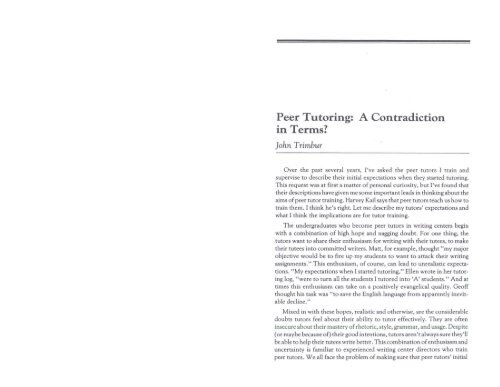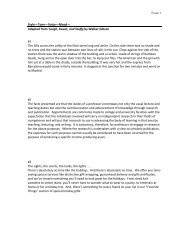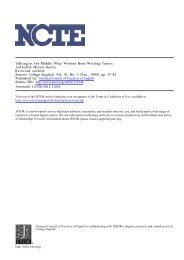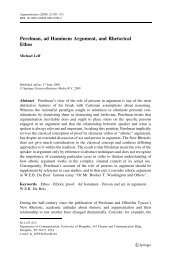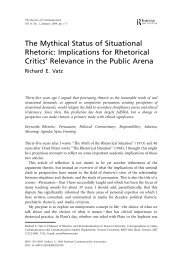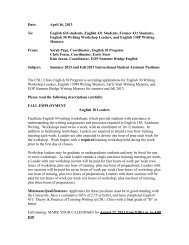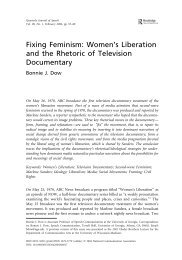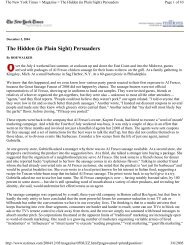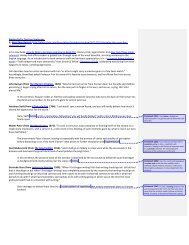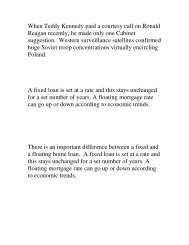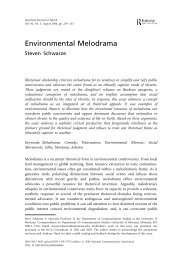Trimbur, “Peer Tutoring: A Contradiction in Terms?” - CompHacker
Trimbur, “Peer Tutoring: A Contradiction in Terms?” - CompHacker
Trimbur, “Peer Tutoring: A Contradiction in Terms?” - CompHacker
Create successful ePaper yourself
Turn your PDF publications into a flip-book with our unique Google optimized e-Paper software.
22 The Wnung Cence. journalPeer <strong>Tutor<strong>in</strong>g</strong>: A <strong>Contradiction</strong> <strong>in</strong> <strong>Terms</strong>! 23expectations don't backfire on them. I've seen it happen. Tutors are delicatemechanisms, without the protective coat<strong>in</strong>g and resiliency most of usdevelop as professionals. So there's the risk tutors' <strong>in</strong>itial expectations willbe shattered, lead<strong>in</strong>g to disappo<strong>in</strong>tment or even cynicism. When theirhopes are not realized, when tutor<strong>in</strong>g sessions don't go well or when tutees'grades don't go up, tutors may start to blame the students they work with.More often, the tutors blame themselves, and their feel<strong>in</strong>gs of <strong>in</strong>adequacycan turn <strong>in</strong>to a debilitat<strong>in</strong>g sense of guilt about not gett<strong>in</strong>g the job done.The problem, however, is not just the tutors' ego, <strong>in</strong>vestment. Theproblem concerns what the tutors have <strong>in</strong>vested their energy do<strong>in</strong>g. Tutors'<strong>in</strong>itial standards for def<strong>in</strong><strong>in</strong>g the aims and evaluat<strong>in</strong>g the results of tutor<strong>in</strong>gare predictably conventional ones, <strong>in</strong>formed by the prevail<strong>in</strong>g reward struc,ture that makes grades the central measure of success <strong>in</strong> higher education. Itcerta<strong>in</strong>ly helps to expla<strong>in</strong> that peer tutor<strong>in</strong>g is more <strong>in</strong>terested <strong>in</strong> thelong,term development of a tutee's writ<strong>in</strong>g ability than <strong>in</strong> the shorHermresults of any given writ<strong>in</strong>g assignment. As Stephen North put it so well, thejob of tutor<strong>in</strong>g is to produce better writers, not just better writ<strong>in</strong>gs. But themode of production tutors are most familiar with is the traditional academicmode of teach<strong>in</strong>g and learn<strong>in</strong>g, a hierarchical structure <strong>in</strong> which the teacherpasses down knowledge to the students and then measures how much thestudents received. This traditional model <strong>in</strong>variably shapes, to one extent oranother, tutors' <strong>in</strong>itial expectations-and can lead to considerable confu,sian about their work as peer tutors.What is a Peer, What is a Tutor?There's a certa<strong>in</strong> irony operat<strong>in</strong>g here because the tutors' hopes anddoubts about their work as peer tutors come <strong>in</strong> part from their own successas undergraduates. As a rule, tutors are highly skilled academic achievers:they are <strong>in</strong>dependent learners, they get good grades, they know how to"psych out" a course, they are accustomed to pleas<strong>in</strong>g their <strong>in</strong>structors.S<strong>in</strong>ce they're used to perform<strong>in</strong>g successfully for evaluation, new tutorstend to measure learn<strong>in</strong>g by grades and to expect that tutor<strong>in</strong>g will raise theirtutees' grades, if not w<strong>in</strong> them "A's."At the same time, however, the traditional model of teach<strong>in</strong>g and learn,<strong>in</strong>g tells new tutors that they are not qualified to tutor, to pass downknowledge to their tutees. As any faculty opponent of peer tutor<strong>in</strong>g will tellyou, students do not possess the expertise and credentials-the professionalstand<strong>in</strong>g-to help their peers learn to write. Accord<strong>in</strong>g to prevail<strong>in</strong>g aca,demic standards, faculty traditionalists are correct: peer tutor<strong>in</strong>g doesn'tmake much sense. If anyth<strong>in</strong>g, peer tutor<strong>in</strong>g looks like a case of the "bl<strong>in</strong>dlead<strong>in</strong>g the bl<strong>in</strong>d."Now most of us <strong>in</strong>volved <strong>in</strong> writ<strong>in</strong>g centers have developed good argu,ments to counter our unreconstructed colleagues. Kenneth A. Bruffeemakes a tell<strong>in</strong>g po<strong>in</strong>t when he argues that peer tutor<strong>in</strong>g replaces the hierarchicalmodel of teachers and students with a collaborative model ofco-learners engaged <strong>in</strong> the shared activity of <strong>in</strong>tellectual work. As writ<strong>in</strong>gcenter directors and peer tutor tra<strong>in</strong>ers, we may feel secure about thesignificance of collaborative learn<strong>in</strong>g and the way it redef<strong>in</strong>es learn<strong>in</strong>g as anevent produced by the social <strong>in</strong>teraction of the learners-and not a body of<strong>in</strong>formation passed down from an expert to a novice. But for the under,graduates who become peer tutors, the <strong>in</strong>securities l<strong>in</strong>ger. Rewarded by thetraditional structure of teach<strong>in</strong>g and learn<strong>in</strong>g, tutors have often <strong>in</strong>ternalizedits values and standards and, <strong>in</strong> many respects, rema<strong>in</strong> dependent on itsauthority.In other words, new tutors are already implicated <strong>in</strong> a system that makesthe words "peer" and "tutor" appear to be a contradiction <strong>in</strong> terms. How,many good tutors want to know, can I be a peer and a tutor simultaneously?If I am qualified to tutor, then I am no longer a peer to those I tutor. On theother hand, ifl am a peer to my tutees, how can I be qualified to tutor? To beselected as a peer tutor <strong>in</strong> the first place seems only to confirm the contradiction<strong>in</strong> terms by acknowledg<strong>in</strong>g differences between the tutors and theirtutees. The tutors' success as undergraduates and their strengths as writerss<strong>in</strong>gle them out and accentuate the differences between them and theirtutees-thereby, <strong>in</strong> effect, undercutt<strong>in</strong>g the peer relationship. Appo<strong>in</strong>tmentto tutor, after all, <strong>in</strong>vests a certa<strong>in</strong> <strong>in</strong>stitutional authority <strong>in</strong> the tutors thattheir tutees have not earned. For new tutors, the process of selection itselfseems to set the terms "peer" and "tutor" at odds. It <strong>in</strong>duces cognitivedissonance by ask<strong>in</strong>g new tutors to be two th<strong>in</strong>gs at once, to play whatappear to them to be mutually exclusive roles.In practice, new tutors often experience cognitive dissonance as a conflictof loyalties. They feel pulled, on one hand, by their loyalty to theirfellow students and, on the other hand, by loyalty to the academic systemthat has rewarded them and whose values they have <strong>in</strong>ternalized. On a gutlevel, new tutors often feel caught <strong>in</strong> the middle, suspended <strong>in</strong> a no,man'slandbetween the faculty and the students.The tutors' loyalty to their peers results from their shared status asundergraduates. Both tutors and tutees f<strong>in</strong>d themselves at the bottom of theacademic hierarchy. Tutors and tutees alike confront a faculty who controlthe curriculum, assign the work, and evaluate the results. This commonposition <strong>in</strong> the traditional hierarchy, moreover, tends to create social bondsamong students, to unionize them. Undergraduates have always bandedtogether to deal with the emotional and cognitive demands of college, and,
24 The Wnc<strong>in</strong>g Ceruer journalPeer <strong>Tutor<strong>in</strong>g</strong>: A <strong>Contradiction</strong> <strong>in</strong> <strong>Terms</strong>?ZS<strong>in</strong> one respect, peer tutor<strong>in</strong>g simply <strong>in</strong>stitutionalizes and accords legitimacyto the practices of mutual aid students have always engaged <strong>in</strong> on their own.But if peer tutor<strong>in</strong>g programs are efforts by educators to tap the identificationof student with student as a potentially powerful source of learn<strong>in</strong>g,peer tutor<strong>in</strong>g can also lead to the further identification of peer tutors withthe system that has rewarded them, underscor<strong>in</strong>g the tutors' personal stake<strong>in</strong> the hierarchical values of higher education. New tutors feel not only thepull of loyalty to their peers. They may also feel the pull of compet<strong>in</strong>gaga<strong>in</strong>st their peers and of ma<strong>in</strong>ta<strong>in</strong><strong>in</strong>g the sense of cultural superiority theacademic hierarchy has conferred on them. Tutors such as Geoff, whom Iquoted earlier, may see themselves as missionaries on a crusade to save theircollege by br<strong>in</strong>g<strong>in</strong>g literacy to the masses. They may <strong>in</strong> fact w<strong>in</strong>d upsound<strong>in</strong>g like our most conservative colleagues. Geoff, for example, went sofar as to suggest that the way the writ<strong>in</strong>g center could improve studentwrit<strong>in</strong>g was to picket the admissions office to raise entrance standards.Now I don't mean to smirk at one tutor. All writ<strong>in</strong>g center directors haveencountered peer tutors who are "bossy" and competitive know-it-ailsunable to extricate themselves from the authoritarian attitudes and behaviorsof the traditional academic hierarchy. Besides, at the other extreme arethose peer tutors who use their superior learn<strong>in</strong>g, <strong>in</strong> this case out of loyaltyto their peers, to co-author student papers, who cross the boundaries of thewrit<strong>in</strong>g center and enter the realm of ghost writ<strong>in</strong>g and plagiarism. If you'relike me, you may f<strong>in</strong>d the latter aberration from the norms of peertutor<strong>in</strong>g-a misguided sense of student solidarity-somewhat easier tocorrect and perhaps more forgivable. But the po<strong>in</strong>t is both <strong>in</strong>stancesthreaten to subvert the educational promise of peer tutor<strong>in</strong>g.These aberrations, of course, are extreme, and happily they are rare. Thevast majority of the peer tutors I've tra<strong>in</strong>ed and supervised have handled theconflict<strong>in</strong>g loyalties they experience with considerable grace and commonsense. The usefulness of look<strong>in</strong>g at these extreme <strong>in</strong>stances is that theyillustrate the social pressures peer tutors are likely to feel. In fact, we mightsay that to become a peer tutor is to <strong>in</strong>vite these pressures. Peer tutor<strong>in</strong>g<strong>in</strong>variably precipitates a crisis of loyalty and identity for the undergraduateswho jo<strong>in</strong> the staff of a writ<strong>in</strong>g center. This crisis, I would argue, is apotentially fruitful one for students. And for writ<strong>in</strong>g center directors andpeer tutor tra<strong>in</strong>ers, it is our unique responsibility to help tutors negotiatethis crisis and put the terms "peer" and " tutor" together <strong>in</strong> practical andmean<strong>in</strong>gful ways.Models of Tutor Tra<strong>in</strong><strong>in</strong>gLet's take a look now at what peer tutors' <strong>in</strong>itial expectations-the hopesand doubts and conflict<strong>in</strong>g loyalties-suggest for tutor tr::.<strong>in</strong><strong>in</strong>g. There is atpresent a considerable body of literature and accumulated experience <strong>in</strong>tra<strong>in</strong><strong>in</strong>g peer tutors. As Nathaniel Hawk<strong>in</strong>s po<strong>in</strong>ts out, this work conta<strong>in</strong>s aproblem similar to the one I've just outl<strong>in</strong>ed. The dilemma for tutortra<strong>in</strong>ers, Hawk<strong>in</strong>s says, is "whether to emphasize the tutor's role [as peerand co-learner] or his knowledge of grammar and theory" (9). We have, onthe one hand, a model of tutor tra<strong>in</strong><strong>in</strong>g that emphasizes the tutor componentof the equation. This model regards the peer tutor as an apprentice and oftendesigns tra<strong>in</strong><strong>in</strong>g courses as an <strong>in</strong>troduction to teach<strong>in</strong>g writ<strong>in</strong>g. The book listfor such a course may well look like ones used <strong>in</strong> a practicum for graduateteach<strong>in</strong>g assistants-Tate's bibliographical essays, Research <strong>in</strong> Compos<strong>in</strong>g,Grave's Rhetoric and Composition, and so on. The second model emphasizesthe peer component. This model casts peer tutors as co-learners. Bruffee'sBrooklyn Plan is no doubt the sem<strong>in</strong>al <strong>in</strong>fluence here, with its focus on thedynamics of collaborative learn<strong>in</strong>g and on the peer tutors' activity as writersand readers. Its goal is not so much to produce expertise as it is to producean experiential knowledge of the process of peer critiqu<strong>in</strong>g and co-learn<strong>in</strong>gto write.Each of these models, of course, has someth<strong>in</strong>g to recommend it. Wewant tutors to know about writ<strong>in</strong>g and to be competent <strong>in</strong> talk<strong>in</strong>g to theirtutees about the compos<strong>in</strong>g process. At the same time, we want them to becapable of collaborat<strong>in</strong>g with their peers and of mak<strong>in</strong>g their own experience<strong>in</strong> writ<strong>in</strong>g and receiv<strong>in</strong>g criticism accessible to their tutees. If the tutorsare not well tra<strong>in</strong>ed, they won't be able to help their tutees. But, as Bruffeeargues, if they are "too well tra<strong>in</strong>ed, tutees don't perceive them as peers butas little teachers, and the collaborative effect of work<strong>in</strong>g together is lost"( 446). Maybe, then, we need what Marv<strong>in</strong> Garrett calls a "delicatebalance"-just the right amount of expertise and theory mixed with just theright amount of peership and collaboration.If you expect me, at this po<strong>in</strong>t, to offer a tutor tra<strong>in</strong><strong>in</strong>g program thatbalances the peer and the tutor components, you're go<strong>in</strong>g to be disappo<strong>in</strong>ted.Let me expla<strong>in</strong> why. At a recent conference on peer tutor<strong>in</strong>g, acolleague suggested that the apparently contradictory nature of peer tutor<strong>in</strong>gcould be resolved by help<strong>in</strong>g tutors develop the judgment to know whento shift roles from that of tutor to that of peer and back aga<strong>in</strong>. <strong>Tutor<strong>in</strong>g</strong>, thatis, is a balanc<strong>in</strong>g act that asks tutors to juggle roles, to shift identity, to knowwhen to act like an expert and when to act like a co-learner. What seems tome the case, however, is that mak<strong>in</strong>g role shifts or balanc<strong>in</strong>g contraryidentities is precisely what peer tutors cannot do. Peer tutors do not possessa strategic ego center outside their experience as peers and tutors fromwhich to maneuver-to make such shifts or to achieve such balances.Rather they are peers and tutors simultaneously. In fact, I would argue thatwe should th<strong>in</strong>k of the terms "peer" and "tutor" not so much as roles to be
26 The Writ<strong>in</strong>g Cencer journalPeer <strong>Tutor<strong>in</strong>g</strong>: A <strong>Contradiction</strong> <strong>in</strong> Tcrms1 27played but as social pressures that converge on peer tutors, lead<strong>in</strong>g to theconflict of loyalty and identity crisis that <strong>in</strong>here <strong>in</strong> peer tutor<strong>in</strong>g. Tutortra<strong>in</strong><strong>in</strong>g, then, is not so much a matter of learn<strong>in</strong>g what roles to play as it is amatter of learn<strong>in</strong>g how to negotiate the conflict<strong>in</strong>g claims on the tutors'social allegiances.Tra<strong>in</strong><strong>in</strong>g and Tim<strong>in</strong>gThe two models of tutor tra<strong>in</strong><strong>in</strong>g-the apprentice model and the co~learner model-reproduce at the professional level the contradiction ofterms "peer" and "tutor" that students experience at a gut level. The tilt oftutor tra<strong>in</strong>ers toward either the peer or the tutor component of the equationcarries important implications not only for tutor tra<strong>in</strong><strong>in</strong>g but also for thedesign and function of peer tutor<strong>in</strong>g programs <strong>in</strong> writ<strong>in</strong>g centers. To followthe apprentice model and emphasize expertise and theory is to conceive ofpeer tutor<strong>in</strong>g as an arm of the writ<strong>in</strong>g program, a way to deliver state~of~the~art <strong>in</strong>struction <strong>in</strong> writ<strong>in</strong>g to tutees. To follow the co~learner model andemphasize collaboration and experiential learn<strong>in</strong>g is to conceive of peertutor<strong>in</strong>g as a semi~autonomous activity that contributes to the formation ofa student culture that takes writ<strong>in</strong>g seriously.I don't pretend these two models can be easily reconciled. It may be thecase, however, that the contradictory nature of the terms "peer" and"tutor" will make more sense if we stop talk<strong>in</strong>g about them <strong>in</strong> spatial terms,as roles to balance, and talk about them <strong>in</strong>stead as a temporal sequence to beplayed out. I want to suggest a rather messy solution to tutor tra<strong>in</strong><strong>in</strong>g that<strong>in</strong>corporates elements from both models but at different stages. What I have<strong>in</strong> m<strong>in</strong>d is a sequence of tutor tra<strong>in</strong><strong>in</strong>g that treats tutors differently depend~<strong>in</strong>g on their tutor<strong>in</strong>g experience-<strong>in</strong> short, that treats tutors develop~mentally. This developmental sequence would beg<strong>in</strong> with a Bruffeesqueapproach to the peer tutors as collaborative learners. Given the way thetraditional hierarchy <strong>in</strong>fluences new tutors' expectations and def<strong>in</strong>itions oftheir activity as tutors, they <strong>in</strong>itially need concrete and practical experienceco~ learn<strong>in</strong>g. Most peer tutors have had important experiences collaborat<strong>in</strong>g<strong>in</strong> everyday life but rarely <strong>in</strong> academic contexts. So they need practice if theyare go<strong>in</strong>g to be effective co~learners. To my m<strong>in</strong>d, this stage is the mostsignificant because it demands that students unlearn some of the values andbehaviors-the competitive <strong>in</strong>dividualism of traditional academics-thathave already rewarded them and shaped their identities as students. Theyneed, <strong>in</strong> effect, to rel<strong>in</strong>quish some of their dependence on faculty authorityand conventional measures of success (the source, we have just seen, of boththeir hopes and doubts as peer tutors) and to experience <strong>in</strong>stead the author~ity co~ learners <strong>in</strong>vest <strong>in</strong> each other as they forge a common language to solvethe problems writers face.Tutors need, that is, to develop confidence <strong>in</strong> their autonomous activityas co~learners, without the sanction of faculty lean<strong>in</strong>g over their shoulderand tell<strong>in</strong>g them and their tutees when someth<strong>in</strong>g is learned and when not.For most new tutors, the terms "peer" and "tutor" come together <strong>in</strong>mean<strong>in</strong>gful ways as tutors learn to work with their tutees, when togetherthey jo<strong>in</strong>tly control their purposes, set the agenda, and evaluate the resultsof their learn<strong>in</strong>g-as autonomous co~learners outside official academicchannels. It is this autonomous activity that creates the social space for peertutor<strong>in</strong>g and makes writ<strong>in</strong>g centers an extension of the social solidarity andcollaborative practices <strong>in</strong> student culture.To return to Kail's remark about how peer tutors teach us how to tra<strong>in</strong>them, I must admit that often new tutors want me to teach them how toteach. They expect me to tell them what to do, to tell them what messages tosend to their tutees, and to give them the methods to deliver these messages.But these questions are part of the old script, the script new tutors br<strong>in</strong>gwith them from their experience <strong>in</strong> the academic hierarchy of pass<strong>in</strong>g downknowledge. The <strong>in</strong>itial stage of tutor tra<strong>in</strong><strong>in</strong>g must address these expectationsbut <strong>in</strong>directly, by structur<strong>in</strong>g activities <strong>in</strong> which new tutors can ga<strong>in</strong>experience co~ learn<strong>in</strong>g. The po<strong>in</strong>t of tutor tra<strong>in</strong><strong>in</strong>g at this stage is to resocial~ize tutors as collaborative learners with<strong>in</strong> student culture. For this reason, Iagree with Bruffee that tutor tra<strong>in</strong><strong>in</strong>g must avoid produc<strong>in</strong>g "littleteachers." It's important to see, though, that the problem is not just thehalf~truth that a little knowledge can be a dangerous th<strong>in</strong>g. The problem isthat knowledge is a powerful th<strong>in</strong>g that aligns people with particular com~munities. To emphasize expertise <strong>in</strong> the <strong>in</strong>itial stages of tutor tra<strong>in</strong><strong>in</strong>g treatstutors as apprentices who are learn<strong>in</strong>g to jo<strong>in</strong> the community of professionalwrit<strong>in</strong>g teachers. I would argue that expertise <strong>in</strong> teach<strong>in</strong>g writ<strong>in</strong>g is not somuch dangerous as it is premature because it takes peer tutors out of studentculture, the social medium of co-learn<strong>in</strong>g.For me, tutor tra<strong>in</strong><strong>in</strong>g is a matter of tim<strong>in</strong>g and community allegiance.The apprentice model of tutor tra<strong>in</strong><strong>in</strong>g <strong>in</strong>vokes a k<strong>in</strong>d of knowledge-thetheory and practice of teach<strong>in</strong>g writ<strong>in</strong>g-that pulls tutors toward the professionalcommunity that generates and authorizes such knowledge. Instead ofimpart<strong>in</strong>g the professional expertise of the community of writ<strong>in</strong>g teachers,tutor tra<strong>in</strong>ers need to tap and organize the native expertise of co~learn<strong>in</strong>gthat is latent <strong>in</strong> the student's own community of undergraduates. What I'margu<strong>in</strong>g is that we need to resist the temptation to professionalize peer tutorsby treat<strong>in</strong>g them as apprentices and by design<strong>in</strong>g tra<strong>in</strong><strong>in</strong>g courses as <strong>in</strong>tro ~ductions to the field of teach<strong>in</strong>g writ<strong>in</strong>g. We need to treat peer tutors asstudents, not as paraprofessionals or preprofessionals, and to recognize thattheir community is not necessarily ours.
Z8The Wrllml( Cenrer journalThrough their tutor<strong>in</strong>g experience, students may well gravitate toward thecommunity of professional writ<strong>in</strong>g teachers, become <strong>in</strong>terested <strong>in</strong> compositionstudies, and perhaps go on to graduate school and careers as writ<strong>in</strong>g teachers.Most of us <strong>in</strong>volved <strong>in</strong> peer tutor<strong>in</strong>g programs have seen this happen. In fact,tutors are <strong>in</strong> general so bright and articulate it is tempt<strong>in</strong>g to look at writ<strong>in</strong>gcenters as recruit<strong>in</strong>g grounds, not just for English or writ<strong>in</strong>g majors but forcolleagues. My po<strong>in</strong>t here is simply that if experienced peer tutors do gravitatetoward our profession, this should grow out of their own experience as colearners<strong>in</strong> the semi-autonomous territory of writ<strong>in</strong>g centers.Tutor tra<strong>in</strong>ers need to nurture the development of experienced tutors asmuch as that of new tutors, and advanced tutor tra<strong>in</strong><strong>in</strong>g courses or practicumscan help tutors deepen their awareness of the collaborative process of learn<strong>in</strong>gto write. Advanced tra<strong>in</strong><strong>in</strong>g courses might well <strong>in</strong>clude composition theory andpedagogy, but this study should take place <strong>in</strong> a developmental sequence of thetutors' <strong>in</strong>terests and purposes-the result of their experience tutor<strong>in</strong>g and not aprerequisite to it. My worry is that the conception of tutor<strong>in</strong>g as an apprenticeshiptreats students as extensions of our profession and can re<strong>in</strong>force theirdependence on faculty authority. To emphasize expertise at the expense of anexperiential knowledge of co-learn<strong>in</strong>g risks short circuit<strong>in</strong>g the dynamics ofcollaboration <strong>in</strong> student culture-the communities of readers and writers that arealways <strong>in</strong> the process of formation when peers work together <strong>in</strong> writ<strong>in</strong>g centers.Works CitedBruffee, Kenneth A. "Tra<strong>in</strong><strong>in</strong>g and Us<strong>in</strong>g Peer Tutors." College English 40 (1978}:432-49.Garrett, Marv<strong>in</strong>. "Toward a Delicate Balance: The Importance of Role-Play<strong>in</strong>g and PeerCriticism <strong>in</strong> Peer Tutor Tra<strong>in</strong><strong>in</strong>g." <strong>Tutor<strong>in</strong>g</strong> Writ<strong>in</strong>g. Ed. Murielllarris. Glenview:Scott, 1981. 94- 100.Hawk<strong>in</strong>s, Nathaniel. "An Introduction to the History and Theory of Peer <strong>Tutor<strong>in</strong>g</strong> <strong>in</strong>Writ<strong>in</strong>g." A Guide to Writ<strong>in</strong>g Programs: Writmg Centers, Peer Tutonng, Wr<strong>in</strong>ng Acrossthe Curriculum. Ed. Tori Har<strong>in</strong>g-Smith. Glenview: Scott, 1984. 7-18.Kail, Harvey. "Collaborative Learn<strong>in</strong>g <strong>in</strong> Context." College English 45 ( I983 ): 592-99.North, Stephen. ''Tra<strong>in</strong><strong>in</strong>g Tutors to Talk about Writ<strong>in</strong>g." College Composition andCommumca(((m 33 ( !982): 434-41.John <strong>Trimbur</strong> is Assistant Professor of Rhetoric, College of Basic Studies, BostonUniversity, where he tra<strong>in</strong>s peer tutors <strong>in</strong> the Writ<strong>in</strong>g Center. He was a Fellow <strong>in</strong> KennethA. Bruffee's Brooklyn College Institute <strong>in</strong> Tra<strong>in</strong><strong>in</strong>g Peer Tutors and has published anumber of articles on peer tutor<strong>in</strong>g, collaborative learn<strong>in</strong>g, and writ<strong>in</strong>g and literarytheory. He co-founded and is currently president of New England Writ<strong>in</strong>g ProgramAdm<strong>in</strong>istrators, is a member of the editorial board of WPA: Writ<strong>in</strong>g Program Adm<strong>in</strong>i.stra'ton, and serves on the CCCC Stand<strong>in</strong>g Committee on the Professional Status of College~omposition and Communications Teachers.Problem .. Solv<strong>in</strong>g <strong>in</strong> the Writ<strong>in</strong>gCenter: From Theory to PracticeGeoffrey W. ChaseThere arc mo ments when I feel as though I'm just go<strong>in</strong>g through the motionsof tutor<strong>in</strong>g writ<strong>in</strong>g. A while ago, for example, a student came <strong>in</strong>to the Writ<strong>in</strong>gCenter, placed a paper <strong>in</strong> front of me and said, "Read this and tell me what youth<strong>in</strong>k." Without a second thought I picked up the piece and tried to focus as thewords blurred past my eyes. When l f<strong>in</strong>ally set the paper down the student wasquick to ask, "Well1" What could I say? I had already started to go through themotions of tutor<strong>in</strong>g writ<strong>in</strong>g, but I wasn't ready to follow through.-Donna Jo Stewart,Writ<strong>in</strong>g Center TutorWe ask a lot of tutors. We want them to respond to many students froma variety of discipl<strong>in</strong>es, work<strong>in</strong>g on a variety of assignments for teachers and<strong>in</strong>structors who have wildly different demands and expectations. We wantthem to help students with immediate problems, and, at the same time, wewant them to help students become more aware of their own writ<strong>in</strong>gprocesses. We want them to diagnose and suggest strategies rather than toedit and to proofread. We want them to treat writ<strong>in</strong>g as a mode of <strong>in</strong>quiry.And, we want them to do all of this very quickly.If tutors are go<strong>in</strong>g to help students with immediate problems, helpstudents th<strong>in</strong>k about their own compos<strong>in</strong>g processes, and do all of thiscoherently, they need to have more at their disposal than a set of exercisesand a grab bag of strategies. They also need some understand<strong>in</strong>g of thecompos<strong>in</strong>g process and of how those various strategies and techniques workwith<strong>in</strong> a larger framework. Tutors need to constantly move back and forthfrom practice to theory, from attention to detail, to larger questions aboutthe writ<strong>in</strong>g process. They need specific strategies and techniques to offerstudent writers, but they also need an overarch<strong>in</strong>g framework that guides


